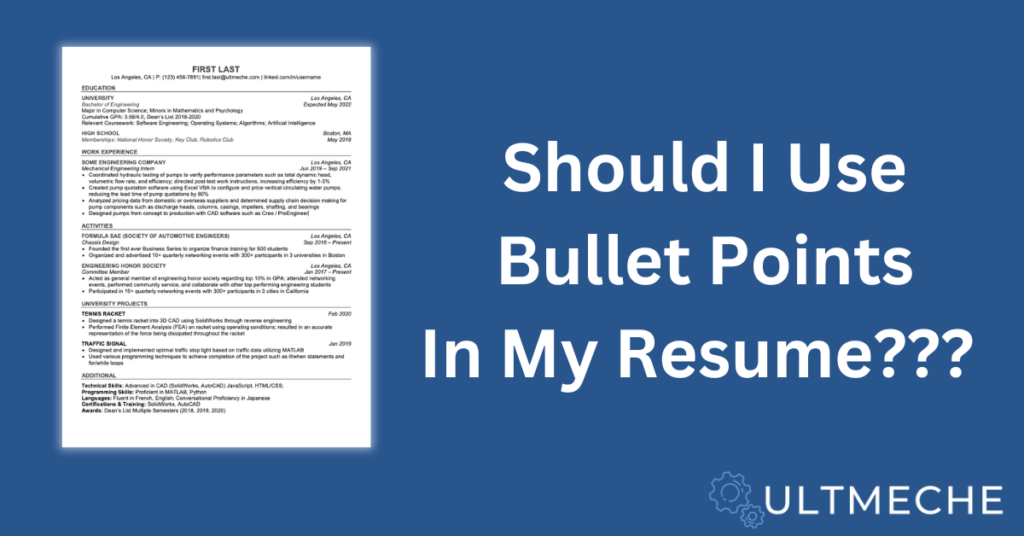When it comes to creating a resume the initial impression is crucial as it can either make or break your chances of getting hired. The decision of whether or not to use bullet points is a one, in this process. Your resume serves as your representation. It’s vital to present your qualifications and experiences in a way that captures the attention of potential employers. Before deciding whether or not to include bullet points in your resume take into consideration your objectives and the specific audience you are targeting by reflecting on yourself and understanding the practices, you can make a decision that suits your individual circumstances.
March 2, 2024
The Pros of Using Bullet Points in Your Resume
Including bullet points in your resume can be an effective way to highlight your key accomplishments and qualifications.
Bullet points make your resume easy to read
They draw the reader’s eye, breaking up dense blocks of text and making your key points quickly scannable. This is important when recruiters spend just a few seconds reviewing each resume.
Bullet points emphasize important details
They highlight key accomplishments, achievements, and points you want to stand out. This helps ensure the reader focuses on your most relevant experience and qualifications.
Bullet points save space
They are a concise way to communicate a lot of information in a small amount of space. This leaves more room in your resume to include additional details and examples to strengthen your application.
Bullet points demonstrate strong communication skills
Your ability to convey complex information in a clear, succinct manner shows you can communicate effectively. This is an important skill that applies to almost any job or industry.
Bullet points are skimmable
They make it easy for readers to skim your resume quickly and still grasp the essential details. Even if a recruiter only spends a few seconds on your resume, the bullet points ensure your most important information is absorbed.
Bullet points break up a resume’s structure
Using a combination of bullet points and full sentences creates visual interest and a balanced layout. Too much of either can seem boring or overwhelming to the reader.
In summary, bullet points are an ideal way to draw attention to key details, strengthen your resume, and demonstrate strong communication abilities. Used effectively, they can help you land an interview for your dream job.
When You Should Avoid Using Bullet Points
While bullet points can be a way to emphasize details or present information in a reader-friendly manner, there are instances where its best to avoid using them in a resume.
Lack of relevant experience
If you have limited experience, a position relying heavily on bullet points might highlight the lack of depth in your work history or qualifications. In cases it’s preferable to use yet meaningful paragraphs that provide more context about your relevant experience. This allows you to showcase the skills and knowledge you’ve gained that would be applicable to the role.
Distracting formatting
Overusing or misusing bullet points can come across as gimmicky. Make your resume challenging to read. It’s advisable to limit their usage to highlight achievements, quantifiable metrics or technical proficiencies. For describing responsibilities and day-to-day tasks, it is more professional to use concise paragraphs composed of sentences.
Lack of context
Bullet points alone often lack context, making it difficult for readers to fully grasp the complexity, scope, or relevance of the information presented. While bullet points can attract attention in a resume there are instances where providing a sentence or two’s necessary, for providing proper context. This is particularly important when discussing leadership positions, managerial roles, or high-impact responsibilities that require skills and business acumen.
Ultimately, the decision to incorporate bullet points in your resume boils down to finding a ground between accentuating details and offering sufficient context for the reader. When used thoughtfully bullet points can be a tool for generating appeal and highlighting essential qualifications. However, it is important to ensure that the majority of your resume comprises structured paragraphs in order to present an overview. By striking the balance and adopting a writing style you can craft a polished and captivating resume, irrespective of its format.
Formatting Bullet Points Effectively
When including bullet points in your resume, formatting them effectively is key to optimizing their impact.
Use Consistent Punctuation
For consistency and an organized appearance, use the same style of bullet points throughout your resume. The most common are the simple dash (—), circle (•), or square (■). Whichever you choose, be sure to use the same bullet for all lists in your document.
Keep Bullet Points Parallel in the Structure
Parallel structure means using the same grammatical form for all items in a list. For example:
- Improved customer satisfaction by 25%
- Streamlined product delivery process
- Reduced costs by 15%
Not:
- Improved customer satisfaction by 25%
- Streamlined the product delivery process
- Costs reduced by 15%
Using parallel structure makes your bullet points easier to read and understand.
Limit Bullets to 3-5 Items
Keep your bullet point lists short and focused. Too many items can overwhelm the reader and diminish the impact. As a general rule, limit yourself to 3 to 5 bullet points per section. If you have additional related points, consider creating another list.
Use Active Verbs and Quantify When Possible
Strong, active verbs bring your resume bullet points to life and highlight your key accomplishments. Quantifying your achievements with metrics, numbers, and percentages further demonstrates your value to the potential employer. For example:
- Increased social media engagement by 40%
- Developed departmental budgets, reducing costs by 18%
- Streamlined customer service process, improving response times 22%
Double Space After Each Bullet Point
Add double spacing after each bullet point for better readability and visual separation. The blank space helps to organize the information and draw the reader’s eye to the next point.
Following these best practices for formatting bullet points on your resume will ensure they have maximum impact and help you land that interview. Consistency, parallel structure, conciseness, and quantified active verbs are the keys to success.
Conclusion
When utilized in a careful manner, bullet points on a resume can efficiently showcase your skills and expertise in a structured and easily readable format. However, be careful not to overuse them and only include them when they add value and clarity for the reader.
Book a resume writing service with us to 10X chances of you landing your dream job.
About the author

Kazuyoshi Fujimoto, PE
Founder | Engineering Career Coach | Principal Mechanical Engineer
Kazu oversees all of ultmeche’s engineering services. He provides consulting such as resume reviews, rewrites, mock interviews, and all services career related. Additionally, Kazu performs consulting work regarding Oil & Gas, Automotive, and Aerospace & Defense. Kazu is licensed as a professional engineer in the state of California and has 9+ years of experience in Oil & Gas, Automotive, and Aerospace & Defense.
